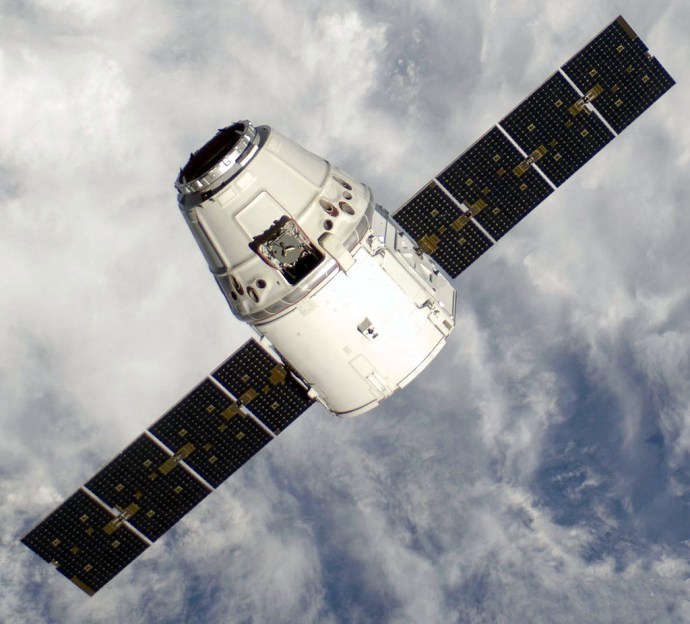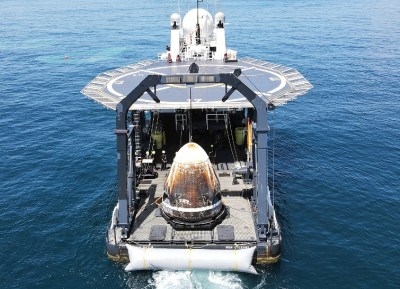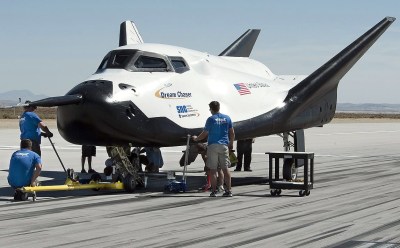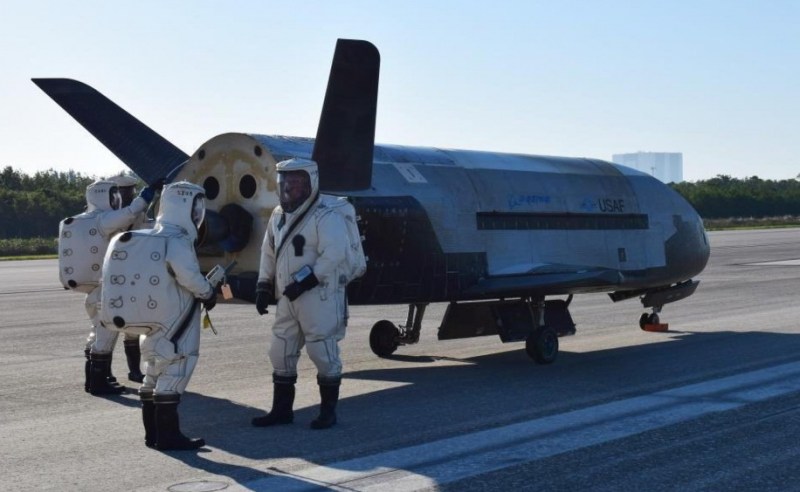When the Space Shuttle Atlantis rolled to a stop on its final mission in 2011, it was truly the end of an era. Few could deny that the program had become too complex and expensive to keep running, but even still, humanity’s ability to do useful work in low Earth orbit took a serious hit with the retirement of the Shuttle fleet. Worse, there was no indication of when or if another spacecraft would be developed that could truly rival the capabilities of the winged orbiters first conceived in the late 1960s.
While its primary function was to carry large payloads such as satellites into orbit, the Shuttle’s ability to retrieve objects from space and bring them back was arguably just as important. Throughout its storied career, sensitive experiments conducted at the International Space Station or aboard the Orbiter itself were returned gently to Earth thanks to the craft’s unique design. Unlike traditional spacecraft that ended their flight with a rough splashdown in the open ocean, the Shuttle eased itself down to the tarmac like an airplane. Once landed, experiments could be quickly unloaded and transferred to the nearby Space Station Processing Facility where science teams would be waiting to perform further processing or analysis.

For 30 years, the Space Shuttle and its assorted facilities at Kennedy Space Center provided a reliable way to deliver fragile or time-sensitive scientific experiments into the hands of researchers just a few hours after leaving orbit. It was a valuable service that simply didn’t exist before the Shuttle, and one that scientists have been deprived of ever since its retirement.
Until now. With the successful splashdown of the first Cargo Dragon 2 off the coast of Florida, NASA is one step closer to regaining a critical capability it hasn’t had for a decade. While it’s still not quite as convenient as simply rolling the Shuttle into the Orbiter Processing Facility after a mission, the fact that SpaceX can guide their capsule down into the waters near the Space Coast greatly reduces the time required to return experiments to the researchers who designed them.
On Dragon’s Wings
While it took nearly ten years to resume crewed launches from American soil after the retirement of the Space Shuttle, there wasn’t nearly as much of a downtime for cargo flights. SpaceX put their first Dragon capsule into orbit in 2010, and just over a year after the final flight of Atlantis, they were ready to begin regular resupply missions to the International Space Station. Not only could the privately developed craft carry a combined 6,000 kilograms (13,000 pounds) of pressurized and unpressurized cargo to the orbiting outpost, it could also bring approximately 3,000 kg (6,600 lbs) back down to Earth.

In comparison, the Shuttle could safely land with around 14,400 kg (31,700 lbs) packed in its cavernous cargo bay. But realistically, that capacity was intended for hauling satellites and was completely overkill for simply returning racks of scientific experiments. Price was also a consideration: a Dragon mission cost NASA just a fraction of what a Shuttle flight did. Combined with the much higher launch cadence of the Dragon, it’s clear which vehicle was better suited to performing regular “milk runs” up to the ISS and back.
But there was a downside. Despite SpaceX’s stated intention to one day perform pin-point propulsive landings with the Dragon, the small spacecraft ended up splashing down in the ocean under parachutes just like the Apollo and Gemini capsules before it. This meant returning to Earth on a Dragon was a much rougher ride than what the Shuttle offered. While not a problem for many payloads, it could be a ruinous experience for sensitive experiments such as those designed to study crystal growth in microgravity.
Further complicating matters was the fact that the capsule came down in the Pacific Ocean, several hundred kilometers off the coast. This made recovery operations easier for the California-based SpaceX, but as NASA lacked suitable payload processing facilities on the West Coast, returning cargo would need to be transported to Johnson Space Center in Houston or all the way back to Kennedy Space Center. The prospect of experiments potentially having to endure a cross-country flight before they could be released to scientists made certain research difficult or impossible to accomplish.
The Human Element
While hardly ideal, landing cargo and experiments on the West Coast and flying them back to Florida was still better than having to transport them back from Kazakhstan if they flew on a Soyuz. But it wouldn’t quite do when it came time for SpaceX to start carrying astronauts as part of the Commercial Crew Program. NASA wanted the primary splashdown point for the new Crew Dragon to be as close to Kennedy Space Center as possible to leverage the existing Shuttle era resources and facilities, with a splashdown in the Gulf of Mexico reserved for contingencies.

This required a considerable expansion of SpaceX’s recovery capabilities. Two ships, GO Searcher and GO Navigator, were procured by the company and outfitted with medical facilities, a helipad, and a lifting apparatus on the stern for hoisting the floating Crew Dragon capsule onto the deck. For redundancy the two craft are virtually identical and can be deployed simultaneously.
With the operational assets and trained personnel moved to East Coast for Crew Dragon, recovering the cargo variant of the spacecraft in California no longer made fiscal sense. Besides, given how similar the two vehicles are, experience gained while pulling the Cargo Dragon from the ocean would serve to improve crewed recovery operations. As NASA’s requirements state that astronauts must egress the capsule within 60 minutes of splashdown, the teams need all the practice they can get.
Beyond the faster delivery time, Cargo Dragon has a number of other advantages over its predecessor. The upgraded capsule has increased payload capacity, twice the number of climate controlled lockers for storing sensitive materials, and a fully autonomous docking system that reduces the workload for astronauts aboard the orbiting outpost. It can also be more easily refurbished for reuse, which not only lowers costs but allows for a higher launch cadence than would be possible otherwise.
Chasing the Dream
With a helicopter waiting to take time-sensitive payloads from the recovery ship to the Space Station Processing Facility, SpaceX can now deliver experiments to scientists between four and nine hours after splashdown. This is a vast improvement over what was possible previously, and arguably the best that can be realistically expected for an off-shore operation. But it’s still not as fast as the Space Shuttle.
Ultimately, having to pull the spacecraft from the ocean and transporting the human crew members or scientific payloads back to land via helicopter will always take longer than simply landing the vehicle at a designated facility. Since SpaceX is no longer pursuing targeted propulsive landings with their Dragon spacecraft, that means another company will have to step up to meet the challenge of truly rapid payload return.

As it so happens, that’s precisely what the Sierra Nevada Corporation hopes to do with their Dream Chaser spaceplane. Currently slated to fly in 2022 as part of NASA’s Commercial Resupply Services-2 program, the vehicle can return as much as 1,750 kg (3,860 lbs) of cargo to a gentle horizontal landing. Being a quarter the size of the Space Shuttle Orbiter, the Dream Chaser has the advantage of being able to use any runway long enough to accommodate a large passenger plane.
This ability to land essentially anywhere on the planet has clear benefits for international scientific collaboration. But more importantly, when the company completes work on their human-rated variant of the spacecraft, it could be a potentially life-saving capability in the event that a medical emergency necessitates a crew member be transported back to Earth as quickly as possible.
Space Force Leads the Way
The fact that multiple commercially operated spacecraft are now in competition to bring cargo and crew members to the International Space Station and beyond is an incredible achievement. It’s something that many people in the industry believed would never happen, and things are just getting started. The next decade will see several more vehicles and boosters come online, all fighting to be the fastest, most reliable, and of course, cheapest. The democratization of space has officially begun.

But as has often been the case historically, it seems that the military is considerably ahead of the curve. The Boeing X-37B spaceplane, now being operated by the newly formed Space Force, is an ideal platform for orbital research and development that in many ways exceeds the capabilities of its commercial peers.
Naturally there’s still a lot we don’t know about the secretive craft, but its ability to conduct free-flying experiments and return scientific payloads from space to a soft runway landing has been publicly demonstrated several times. Being fully autonomous, the X-37B is also able to remain in orbit for far longer than any crewed vehicle. This provides a unique opportunity to conduct long-duration experiments in complete isolation; something that simply isn’t possible on the bustling International Space Station.
As you might expect for a shadowy military operation, most of the research being conducted aboard the X-37B is classified. Some believe the vehicle is designed to evaluate new reconnaissance equipment and techniques, while others think its a test platform for anti-satellite weaponry. But there are signs that the Space Force is willing to share its miniature spaceplane with non-military researchers, with the last launch in May carrying a record number of NASA experiments.
In the end, none of these vehicles can carry more scientific payload than the Space Shuttle, and to date, only the government-operated craft is able to approach the sort of rapid turnaround necessary for the truly time-sensitive experiments. But for the first time in history there’s an array of competitive choices available to researchers who want to get their payload into space and back down in one piece; and that’s definitely a step in the right direction.















In the context of the current space game of rich boys spending other-people’s-money: Seeing in the graphic “SPAC Ex” I could not help but be reminded of the current infatuation with SPACs and Alan Greenspan’s comment on financial “Irrational Exuberance”.
I’m sure we would all be much happier living in your feet on the ground, never spend a dime, and never progress hunting and gathering utopia.
I don’t know what mindset it must take to leap to that conclusion from what I wrote, but it doesn’t sound very healthy.
It’s a curious response, but all too common. If you speak anything against some frivolous boondoggle, people go “Why do you hate progress?”
The fourth industrial revolution failed to arrive exactly because the technologies that were supposed to bring it along were built on baseless hype. There are plenty of people throwing their money at it, so it’s not a problem of a few individuals saying “that won’t work”. The problem is that it actually doesn’t.
” It can also be more easily refurbished for reuse, which not only lowers costs but allows for a higher launch cadence than would be possible otherwise.”
But it’s landing in the water? I thought they only reused them when they land on the barge. Between the thermal shock of hot metal plunging into liquid and the fact that the liquid is full of corrosive salts I would think water landings are a one time deal.
Are you thinking of the boosters maybe? The Dragon capsules have always come down in the water and have been getting reused for quite some time now.
I’m sure it would be preferable to not have them get wet, but there doesn’t seem to be much choice in the matter.
Yup. That’s exactly what I was thinking of. Thanks.
Hmm.. I wonder how they deal with those issues with the capsule.
Run it through the car wash on the back of the truck on the way home, if you select premium, they do a full rust inhibitor spray.
LOL!
Himmmm maybe since it”s not hot metal….
I’m struggling to see the massive benefit of decreasing the time to get experiments into the hands of the experimenter. The article goes on and on about it as though its hugely important but… is it? What exactly is the improvement here? This is the first time I’ve heard of that even being a consideration.
Deterioration under normal gravity perhaps? Needing to get delicate structures examined by huge machines like electron microscopes that don’t go to space yet.
Living cultures/samples is a pretty obvious example. This mission in particular returned heart tissue samples that were grown in space. They also occasionally bring back mice and other small creatures that can’t survive long in a cargo craft that doesn’t have active life support systems.
Material that can’t be exposed to high G forces is less common. Like the article states, mostly you’re talking about crystal structures that might collapse during splashdown.
Anyone else think the Dreamchaser looks like both the ship in Spaceman in Kin Arthurs Court aka Unidentified Flying Oddball https://static.wikia.nocookie.net/disney/images/c/c4/Extrait_unidentified-flying-oddball_1.jpg AND the French Hermes concept… https://en.wikipedia.org/wiki/Hermes_(spacecraft) AND the X-20 Dynosaur AND the Martin X-23
Not surprising in that the ship in Spaceman was probably based on the X-23 and Dynasoar projects, and the French Hermes and Dreamchaser follow very similar constraints to the dynasoar leading to very similar design outcome. They’re all in basically the same class, so it’s not surprising they end up looking very similar.
It’s like remarking the US STS (Space Shuttle) and the USSR Buran look very similar. That’s not through spying (though it might have had SOME influence) but through convergent design, similar constraints on the flight profile lead to similar design outcome.
It doesn’t hurt that the copy was also designed using leaked engineering
the X-37B seems the way to go for many things – why bother with a crew just to go up and down? They take space, weight, support systems, and extra safety etc etc..